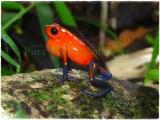Oophaga pumilio
(Strawberry poison dart frog)
Oophaga pumilio : Photo by Claudio Mejía
Habitat: These frogs live in the undergrowth, and in vegetation (10-90 cm. high) in the highly humid tropical forests. They also live in secondary forests such as in abandoned cacao or banana plantations.
Territory: The males defend their song territory by a combination of physical and vocal combat. It is known that the contest between adult males for their territories is closely connected to the amount of bromeliads in the area (the location of tadpoles, the tadpoles live in the bromeliads)
It has been determined that the local density of the territorial males is limited by the amount of bromeliads, and the local behavior probably results from a superior limit to the size of the population. The females do not defend the territory.
On the other hand, other investigations support the theory that the frogs select their territory partly based on the amount of ants in the area.
It has been suggested that their minimal territory is 2.5 sq. m. in size.
Feeding: They feed primarily on ants and termites, since this prey is very small, the frogs spend much time and energy in getting their food. They also eat, among other such things, diptera, isopods, and arthropods.
The feeding takes place during the time you hear them sing, and during their preferred time for mating. The males apparently are capable of combining the feeding with the singing, which should aid in defending the territory. However, the males do not feed during the courting.
Behavior: The aggressive behavior of the male (while defending his territory) includes their grabbing each other by the stomach (also by the armpits and groin area) During many of the meetings, the frogs emit a sporadic, murmuring call. Also, it has been found that the vocalizations of the males work as an effective mecanism to maintain an effective distance between them, which gives security to the male to reinforce his behavior through occasional attacks and struggles.
The vocalizations of the male also work to attract the females and plays an important part in finding an appropriate site for courting, ovipositing, and it prevents interference from other competitors.
In the Hitoy Cerere Biological Reserve, 20 males and 29 females were observed; 14 males were territorial and defended their territories of 24.5 square meters in size. The activity of the males started after 7am. and reached a peak between 8-10 am., with an average of 40% of the territorial males involved.
Distribution in Costa Rica: They are found in the humid lowlands of the Atlantic slope; between 1 and 500 m. of elevation. (Savage, 2002)
This information was used and translated with permission from INBio ( www.inbio.ac.cr ) Exact link: http://darnis.inbio.ac.cr/ubis/FMPro?-DB=UBIPUB.fp3&-lay=WebAll&-error=norec.html&-Format=detail.html&-Op=eq&id=4398&-Find
 | { Photo of an Oophaga pumilio singing. |
This is a sample of the Oophaga pumilio's song. You might have thought that it was a cricket if you have heard it.

|
Oophaga pumilio song.wav Size : 0.814 Kb Type : wav |